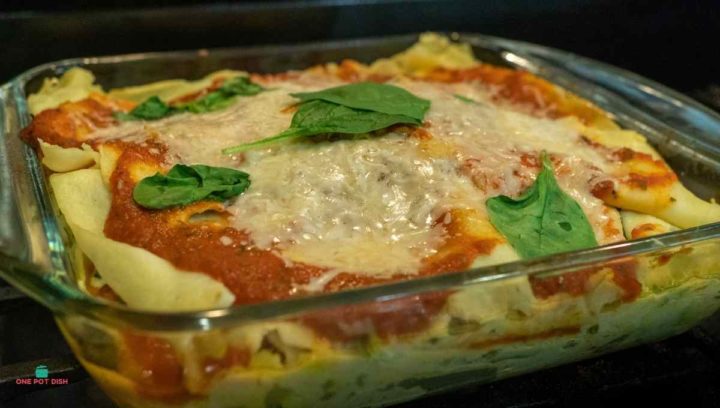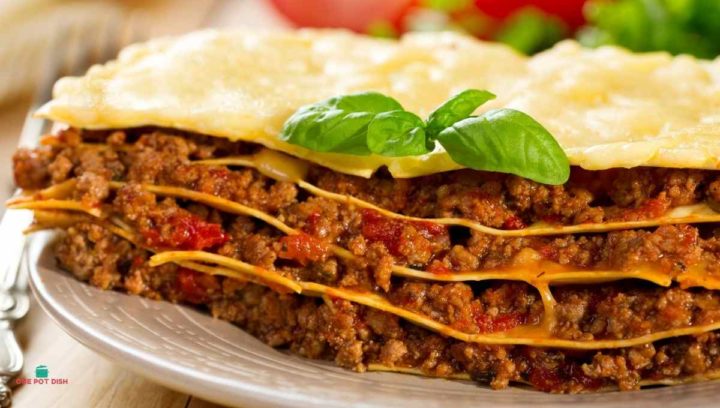Lasagna has everything you want in a dish—an umami kick, layers and layers of meat and cheese, and topped with a delectable bechamel sauce.
If you’re feeling particularly creative, you can even add some sun-dried tomatoes, use different kinds of cheeses, and artichoke hearts to the dish.
Cooking the perfect lasagna is easy, but sometimes, the kitchen gods won’t be in your favor.
Your lasagna can come out as watery, and if you don’t want this nightmare happening to you, it’s best you know what causes it, how to fix it when it happens, and how to prevent the risk of it happening again in the future.
My Lasagna is Done Too Soon, plus check out how to make Lasagna for a crowd.
We also have a really nice Eggplant Lasagna recipe.
Watery lasagna is caused by inaccurate ingredient proportions, fatty beef, runny sauce, overfilling, overlaying, and slicing when fresh.
You can fix these by accurately measuring ingredients, using lean beef, draining excess water, avoiding overfilling and overlayering, and letting the dish sit before slicing.

What Makes Lasagna Watery And Ways Of Fixing It
Whether you’re a beginner or a pro at whipping up some lasagna, making mistakes that ultimately lead to the lasagna coming out as soup-like is perfectly normal, practice makes perfect, and as long as you learn from your wrongs, you’ll know how to prevent it from happening next time.
Also cooking it for the right amount of time – see how long to cook lasagna at 350F
Ingredients and the attributed cooking procedures are what mostly cause lasagna to be moist. Read the following sections to find out more:
1. Inaccurate Ingredient Proportions
Vegetables used in making lasagna have high water content such as tomatoes (95%), bell peppers (89%), zucchini (94%), carrots (86% to 95%), mushrooms (85% to 95%), broccoli (90%), spinach (93%), yellow squash (95%), and cauliflower (92%).
This means that once you cook them and you may have used too much of each when layering the lasagna, they can give off a lot of moisture to the whole dish by releasing water.
You can fix this by:
- Accurately measuring each ingredient using the right tools such as measuring cups, spoons, bowls in getting the right proportions. Avoid using liquid measuring cups.
- Saute vegetables or soak them in salt before cooking.
- Drain excess liquids from the ingredients after cleaning them.
- Grate instead of chopping or slicing the vegetables.
2. Using Fatty Beef
The use of fatty beef is tempting especially when you’re on a tight budget and you want to save up as much as possible. However, in doing so, you’re risking the quality of your homemade lasagna. Fattier beef is cheaper than thinner ones and they have higher levels of moisture, making your lasagna runny.
You can fix this by:
- Leave the meat uncovered in a container in the refrigerator.
- Drain moisture out of the meat by patting it using a paper towel. You can also salt-cure it so that lesser amounts of water will escape once cooked.
- Select pre-cured or pre-dried meat when purchasing from your local butcher or grocery stores if possible.
- Cook the beef on a high-heat pan.
- Purchase lean ground beef if you can.

3. Runny Sauce
It makes sense that the sauce would be the main culprit, whether it’s the bechamel sauce, amount of cheese, or the meat sauce itself. Your sauces may have too much liquid content in it since it’s primarily made out of tomatoes, making it too thin and runny. Your baked dish will definitely turn out watery.
You can fix this by:
- Draining any excess liquid on the meat sauce prior to adding in the lasagna.
- When you’ve already added the runny sauce, reduce the amount by draining carefully until all the liquid has vanished.
- Thicken your sauce by adding a small amount of tomato paste, cornstarch, flour, or baking soda.
- Purchase full-fat cheese and remove any excess liquid. You can also try adding one or two eggs to the cheese mixture.
4. Overfilling And Overlayering
Whether it’s sauce or meaty fillings, avoid overfilling and overlayering them on your lasagna. It may be tempting and oh so delicious to have more meat and more lasagna in general, you might want to avoid doing so or else you’ll get a goopy lasagna.
You can fix this by:
- Following the recommended amount of meat filling and sauce.
- Your dish should ideally have only 3 to 4 layers of cheese, meat, and other ingredients.
- Avoid overcooking your uppermost lasagna layer by covering with foil when you’re nearly done cooking although you have to be extra careful as the foil can trap moisture in.
5. Slicing When Fresh
It’s totally understandable that you’re excited to try out your homemade lasagna, especially when you’re a newbie. Even if you follow all the rules and recommendations of top chefs, if you slice lasagna way too early when it’s still oven-hot, chances are you’d still get watery lasagna.
You can fix this by:
- Letting the lasagna sit for about 20 to 30 minutes. Don’t worry because it definitely won’t go cold and the ingredients will have all the time to mix well.
- Baking a day before and storing it in the refrigerator all wrapped up tightly in foil and plastic wrap.
Additional Tips When Cooking Lasagna
Other tips in baking the best lasagna is using fresh vegetables so that there would be less moisture for you to drain out. Cook on a glass dish when you can instead of a ceramic dish so that you could properly monitor and remove the moisture content of the lasagna.
Use an oven thermometer to properly measure the temperature of the lasagna and you can also use it for other recipes. Bake at a higher temperature and make sure it coincides with your thermometer for the best results.
With regards to cooking, experiment and build a great-tasting flavor profile for your lasagna. Just make sure you don’t have a lot of add-ons to avoid overfilling your baked dish. Choose the right noodles, cheese, and meat—and don’t forget to layer it correctly!